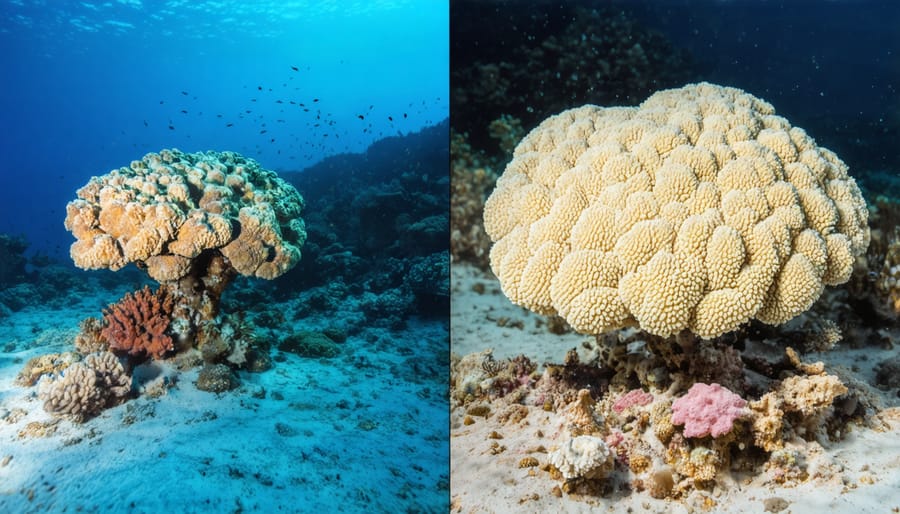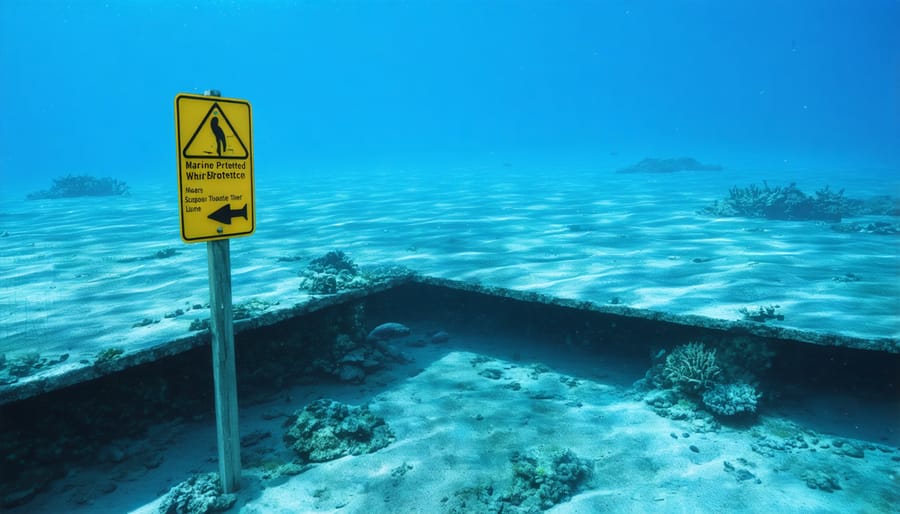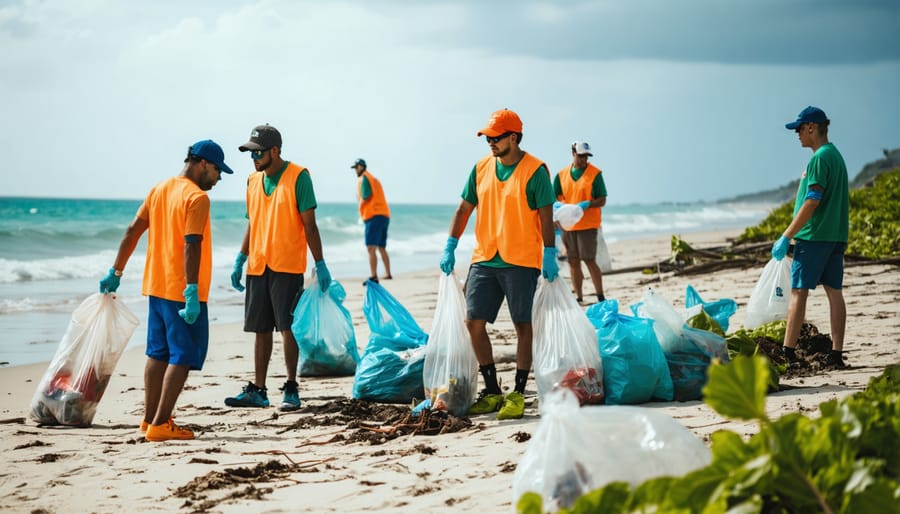
Beneath the shimmering surface of our oceans lies a delicate ecosystem teetering on the edge of unprecedented change. Marine life, from microscopic phytoplankton to majestic blue whales, forms an intricate web of biodiversity that sustains not just ocean health but the entire planet’s wellbeing. Yet, this remarkable underwater world faces mounting threats from climate change, plastic pollution, overfishing, and habitat destruction.
Recent studies reveal that nearly 50% of marine species have declined in the past four decades, signaling an urgent need for immediate action. This isn’t just about preserving beautiful coral reefs or saving endangered species – it’s about maintaining the critical balance that keeps our oceans healthy and, by extension, ensures human survival. The oceans produce over 50% of the world’s oxygen and absorb nearly one-third of human-caused carbon dioxide emissions.
As marine biologists and conservationists work tirelessly to understand and protect these vital ecosystems, a growing global movement of citizen scientists, volunteers, and conscious consumers is emerging. Through collaborative efforts between scientific communities, local organizations, and individuals, we’re witnessing innovative solutions and promising developments in marine conservation. The time for action is now, and everyone – from seaside communities to inland citizens – has a crucial role to play in safeguarding our marine heritage for future generations.
The Growing Threats to Marine Biodiversity
Climate Change and Ocean Acidification
Climate change poses one of the most significant threats to marine ecosystems worldwide. Rising global temperatures are causing sea levels to rise and water temperatures to increase, disrupting the delicate balance of marine habitats. Many species, particularly coral reefs, are experiencing unprecedented stress from these changes, leading to widespread bleaching events and ecosystem collapse.
Equally concerning is ocean acidification, a process where increasing atmospheric CO2 levels cause seawater to become more acidic. This chemical change makes it difficult for shellfish, corals, and other calcifying organisms to build and maintain their shells and skeletal structures. Scientists have observed that some pteropods, also known as sea butterflies, are already showing signs of shell dissolution in affected areas.
The combined effects of warming waters and acidification are particularly devastating for coral reef ecosystems, which support approximately 25% of all marine species. These changes also impact the migration patterns of various marine species, affecting breeding cycles and food availability throughout the ocean’s food web. Understanding and addressing these climate-related challenges is crucial for the long-term survival of marine biodiversity.

Overfishing and Destructive Fishing Practices
Overfishing has emerged as one of the most critical threats to marine ecosystems, with nearly one-third of global fish stocks being exploited at unsustainable levels. Commercial fishing fleets, equipped with advanced technology and massive nets, can now access previously unreachable areas, leading to the rapid depletion of fish populations that cannot reproduce quickly enough to maintain stable numbers.
Destructive fishing practices compound this problem. Bottom trawling, where heavy nets are dragged across the seafloor, destroys vital habitat and coral reefs that take decades to recover. Blast fishing, though illegal in most regions, continues to devastate reef systems in parts of Southeast Asia. Even longline fishing, while more selective, results in significant bycatch of non-target species including sea turtles, dolphins, and seabirds.
The consequences extend beyond targeted species. When key predator or prey species are removed in large numbers, it triggers a cascade effect throughout the food web, destabilizing entire marine communities. Local fishing communities also suffer as their traditional fishing grounds become depleted, forcing them to travel farther or abandon their livelihoods altogether.
Plastic Pollution and Marine Debris
Plastic pollution poses one of the most severe threats to marine ecosystems, with an estimated 11 million metric tons of plastic entering our oceans annually. Marine animals frequently mistake plastic debris for food, leading to malnutrition, internal injuries, and often death. Sea turtles mistake floating plastic bags for jellyfish, while seabirds feed plastic pieces to their chicks, mistaking them for fish. Microplastics, particles smaller than 5mm, have infiltrated every level of the marine food chain, from plankton to large predators. These tiny particles absorb toxic chemicals and can accumulate in marine animals’ tissues, potentially affecting entire food webs. Ghost fishing gear – abandoned nets and fishing equipment – continues to trap and kill marine life long after being discarded, creating deadly underwater snares. The impact extends beyond individual casualties, disrupting delicate marine ecosystems and threatening biodiversity across our oceans.
Successful Marine Conservation Strategies
Marine Protected Areas
Marine Protected Areas (MPAs) represent one of our most effective tools in preserving marine ecosystems and safeguarding endangered species. These designated zones act as underwater sanctuaries where marine life can thrive without the pressures of commercial fishing, resource extraction, or excessive human activity.
Research has shown that well-managed MPAs can increase fish populations by up to 400% within their boundaries, with positive spillover effects extending to surrounding waters. For instance, the Cabo Pulmo National Park in Mexico has seen a remarkable 460% increase in total fish biomass since its establishment in 1995.
These protected zones serve multiple crucial functions: they provide safe breeding grounds for marine species, protect critical habitats like coral reefs and seagrass beds, and maintain biodiversity hotspots. They also act as living laboratories where scientists can study marine ecosystems in their natural state.
Success stories from MPAs worldwide demonstrate their effectiveness. The Great Barrier Reef Marine Park has helped preserve thousands of species, while California’s Channel Islands Marine Protected Areas have shown significant increases in both the size and abundance of spiny lobsters and other commercial species.
However, the success of MPAs depends heavily on proper enforcement and community support. When local communities are involved in management decisions and benefit from conservation efforts, these protected areas become powerful tools for both environmental preservation and sustainable economic development.

Sustainable Fishing Practices
Sustainable fishing practices form the cornerstone of marine conservation efforts, balancing the needs of human communities with the preservation of ocean ecosystems. These practices focus on maintaining fish populations at healthy levels while minimizing impact on marine habitats and non-target species.
Key sustainable fishing methods include selective gear usage, such as modified nets with escape panels for juvenile fish and turtle excluder devices. These innovations help reduce bycatch – the accidental capture of non-target species – by up to 90% in some fisheries.
Quota systems and seasonal restrictions play vital roles in sustainable management. For instance, the Alaska pollock fishery demonstrates how science-based catch limits can maintain healthy fish populations while supporting commercial fishing. Regular population assessments ensure harvesting remains within sustainable limits.
Marine protected areas (MPAs) serve as crucial tools for fish stock recovery. These designated zones allow marine populations to reproduce and grow undisturbed, ultimately supporting surrounding fisheries through the spillover effect.
Certification programs, like the Marine Stewardship Council (MSC), help consumers make informed choices while incentivizing sustainable practices among fishing operations. These programs have led to documented improvements in fishing methods and marine ecosystem health.
Technology also enhances sustainability through real-time monitoring systems and improved tracking of fishing vessels, helping prevent illegal fishing and ensuring compliance with regulations. Innovations in gear design continue to evolve, making fishing more selective and less harmful to marine habitats.
Habitat Restoration Projects
Recent years have witnessed remarkable success in habitat restoration projects worldwide, offering hope for marine ecosystem recovery. The Great Barrier Reef’s Coral IVF project has demonstrated promising results, with scientists successfully breeding and transplanting coral larvae to damaged reef areas, leading to a 67% survival rate of new coral colonies.
In the Caribbean, community-led initiatives have restored over 100 acres of mangrove forests, creating crucial nursery grounds for juvenile fish and protecting coastlines from erosion. These projects combine traditional ecological knowledge with modern restoration techniques, engaging local fishermen and volunteers in the planting and monitoring process.
The Mediterranean’s Posidonia oceanica seagrass restoration program has successfully rehabilitated degraded coastal areas, with restored meadows now supporting diverse marine life, including endangered species. Marine biologist Dr. Elena Martinez shares, “Watching previously barren seafloor transform into thriving seagrass meadows within just three years has been incredibly rewarding.”
Innovative techniques like reef balls and 3D-printed coral structures have revolutionized restoration efforts. In Florida, these artificial reef structures have attracted over 50 species of fish and provided new substrate for coral growth. Volunteer programs allow citizen scientists to participate in monitoring these sites, creating valuable data for researchers while fostering community engagement in marine conservation.
These success stories demonstrate that with proper planning, community involvement, and scientific expertise, we can effectively restore critical marine habitats and support biodiversity recovery.
Community Action and Involvement

Volunteer Opportunities
Marine conservation offers numerous opportunities for individuals to make a meaningful impact through volunteer work and citizen science initiatives. Organizations worldwide welcome volunteers for activities ranging from beach cleanups to coral reef monitoring programs. These hands-on experiences not only contribute to scientific research but also provide valuable learning opportunities for participants.
Coastal cleanup programs represent one of the most accessible ways to get involved. Regular beach cleaning events help remove harmful debris while collecting crucial data about marine pollution patterns. Many organizations provide training and equipment, making it easy for newcomers to participate effectively.
Coral reef monitoring programs offer more specialized volunteer opportunities. After completing basic training, volunteers can assist in surveying reef health, documenting marine species, and collecting data on coral bleaching events. These programs often operate in tropical locations, combining conservation work with unique travel experiences.
Citizen science projects have revolutionized marine research by enabling anyone with a smartphone to contribute to scientific studies. Mobile apps allow users to report marine mammal sightings, document unusual species appearances, or track invasive species movements. This collected data helps researchers understand migration patterns and population dynamics.
Sea turtle conservation programs particularly welcome volunteers during nesting seasons. Activities include protecting nesting sites, monitoring hatching success, and helping ensure hatchlings safely reach the ocean. These programs often operate at night, offering a rare glimpse into these ancient creatures’ breeding habits.
For those unable to participate in field activities, virtual volunteering opportunities exist through data analysis, social media advocacy, and educational outreach programs. Many organizations also offer remote training sessions and webinars to help volunteers develop necessary skills for marine conservation work.
Sustainable Consumer Choices
Making sustainable consumer choices can significantly impact marine ecosystem health. Every purchase decision we make has ripple effects on our oceans, from the products we use daily to the seafood we consume.
When shopping for seafood, look for Marine Stewardship Council (MSC) certification, which ensures the fish comes from sustainable fisheries. Download seafood guide apps to make informed choices at restaurants and markets. Choose locally caught seafood when possible to reduce transportation emissions and support sustainable fishing communities.
Avoid single-use plastics by opting for reusable alternatives. Select products with minimal packaging or those made from recycled materials. When buying personal care products, check ingredient lists for harmful compounds like microbeads, oxybenzone, and triclosan, which can damage marine ecosystems.
Choose eco-friendly cleaning products that break down naturally without harming aquatic life. Look for phosphate-free detergents and biodegradable formulas. Many conventional cleaning products contain chemicals that eventually make their way into our oceans through wastewater systems.
Consider the entire lifecycle of products before purchasing. Items made from recycled ocean plastic help clean our seas while creating demand for waste collection. Support companies that demonstrate commitment to ocean conservation through their manufacturing processes and corporate policies.
Remember that small changes in shopping habits can create significant positive impacts when adopted by many consumers. By making thoughtful purchasing decisions, we contribute to healthier marine ecosystems and inspire others to follow suit.
Future of Marine Conservation
The future of marine conservation is being revolutionized by groundbreaking technologies and innovative approaches. Advanced satellite tracking systems now enable scientists to monitor marine species and illegal fishing activities in real-time, while environmental DNA (eDNA) sampling allows researchers to detect species presence without direct observation.
Artificial intelligence and machine learning are transforming how we analyze ocean data, predict migration patterns, and identify threatened areas. These technologies, combined with collaborative conservation efforts, are creating more effective protection strategies for marine ecosystems.
Emerging solutions include autonomous underwater vehicles (AUVs) that map ocean floors and monitor coral reef health, and smart buoys that collect data on water quality and marine life movements. Biotechnology is also playing a crucial role, with scientists developing coral restoration techniques and sustainable alternatives to plastic.
Community-based conservation programs are increasingly incorporating traditional ecological knowledge with modern science, creating more holistic approaches to marine protection. Citizen science initiatives, powered by smartphone apps and online platforms, are enabling the public to contribute valuable data to research efforts.
Looking ahead, the integration of blockchain technology for transparent seafood supply chains and the development of biodegradable materials show promise in addressing marine pollution. These innovations, coupled with growing public awareness and participation, offer hope for the future of our oceans and their inhabitants.
The preservation of marine life stands as one of our era’s most crucial environmental challenges, yet it’s also an area where individual actions can create meaningful change. From reducing plastic consumption to supporting sustainable fishing practices, every step we take contributes to healthier oceans. Marine scientists and conservationists have shown that when communities work together, marine ecosystems can recover and thrive. By participating in beach cleanups, choosing sustainable seafood options, and educating others about marine conservation, we can all become stewards of our oceans. The time to act is now – our marine ecosystems depend on immediate and sustained action from all of us. Together, we can ensure that future generations inherit vibrant, diverse oceans teeming with life. Join a local conservation group, support marine research, or start your own initiative today. The ocean’s future is in our hands.
jessica
Ava Singh is an environmental writer and marine sustainability advocate with a deep commitment to protecting the world's oceans and coastal communities. With a background in environmental policy and a passion for storytelling, Ava brings complex topics to life through clear, engaging content that educates and empowers readers. At the Marine Biodiversity & Sustainability Learning Center, Ava focuses on sharing impactful stories about community engagement, policy innovations, and conservation strategies. Her writing bridges the gap between science and the public, encouraging people to take part in preserving marine biodiversity. When she’s not writing, Ava collaborates with local initiatives to promote eco-conscious living and sustainable development, ensuring her work makes a difference both on the page and in the real world.
